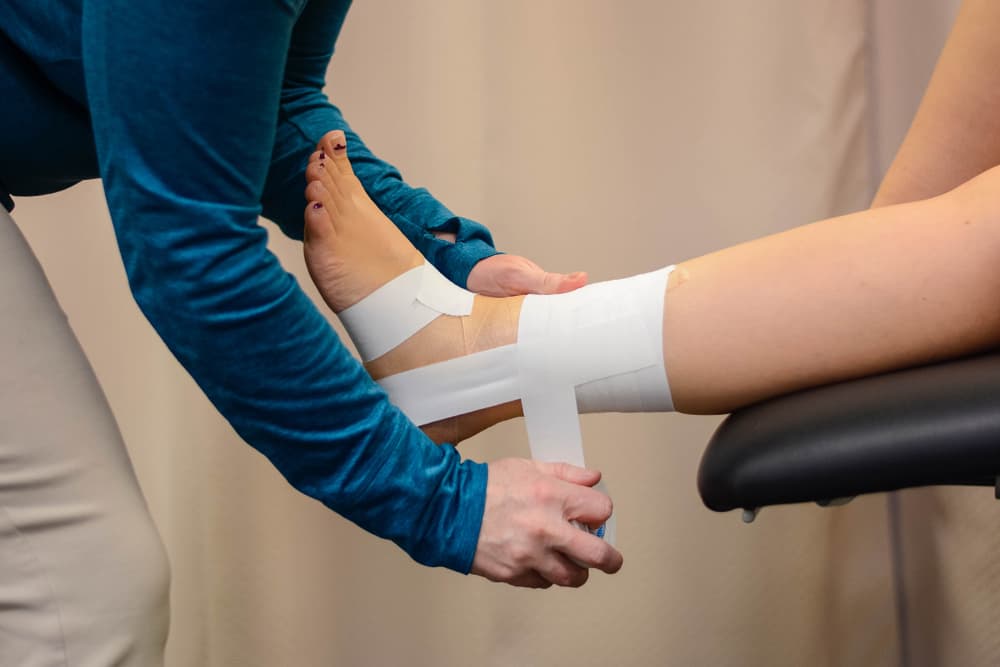An ankle sprain is one of the most common musculoskeletal injuries. It occurs when the ankle turns inward, leading to a tear in some or all of the ligaments around the ankle. Ligaments of the ankle joint are stretched or torn.
Risk factors for developing an ankle sprain include: a history of previous sprains, participation in high-risk sports (basketball, volleyball, soccer, etc.), a high arch, or an excessively loose joint.
The severity of a sprain will determine the length of recovery time. Initial treatment includes: rest, activity modification, ice, elevation, and compression. Physical therapy focuses on range of motion and strengthening, and is especially helpful once the initial pain and swelling subsides.
Table of contents
Symptoms
Patients with an ankle sprain usually describe an episode where they roll their ankle inward, which tears the ligaments on the outside of the ankle. Patients usually immediately have significant pain and swelling, and are usually limping or unable to walk immediately after the injury. However, quite often those who have sprained their ankle are still able to bear some weight.
It is often possible for athletes who have suffered a mild or even moderate ankle sprain to be unable to complete their game, albeit with significant pain and some functional limitations. Swelling and redness (bruising) usually become apparent within 24 hours of the injury and tend to spread down the leg. Bruising can take two weeks or more to resolve.


Symptoms may include:
- Pain
- Swelling
- Bruising
- Stiffness
- Inability to weight bear
Causes
Causes may include:
- Sports injuries, especially in sports that require frequent jumps or pivoting, ie basketball, volleyball, or soccer.
- Falls from height
- Simple everyday walking, ie ankle twisting in the curb
- Inappropriate shoes
- Prior history of multiple sprains - ankle instability


Classification
The symptoms caused by an ankle sprain vary depending on the severity of the sprain, as well as the ligaments it affects. Some sprains involve damage to multiple ligaments. Doctors often give a "grade" to sprains (grade 1, 2, or 3), depending on their severity:
- 1st degree sprains are mild and occur when there is a stretch and microscopic tear of the ligaments of the ankle joint. They usually cause only mild pain and swelling. A mild sprain involves a partial tear of the anterior talofibular ligament (ATFL) – the first ligament to be stretched when the ankle turns inward. In a mild sprain, this ligament has been stretched or some fibers are torn, but is intact. Mild sprains will take 4-7 days to recover.
- 2nd degree sprains are of moderate intensity and occur when the ligament is partially torn. They cause moderate pain and swelling. They are usually accompanied by partial damage to the ATFL and CFL (calcaneofibular ligament). Grade 2 ankle sprains often take 7-14 days to fully recover.
- 3rd degree sprains are serious and occur when a ligament is completely torn (complete tear). There is usually complete failure of the ATFL & CFL +/- PTFL. They can cause significant pain and swelling that can make it difficult to move the ankle. A grade 3 sprain may require 4-6 weeks of treatment.
Although all sprains can be painful, very severe pain generally means a more serious sprain is present.

Diagnosis
Dr Panagopoulos will take a detailed history and examine you carefully. On clinical examination of a sprain there is usually swelling in the area around the ankle and pain on palpation or movement of the joint. It is important to assess other areas of tenderness and potential injury, as the same mechanism that creates an ankle sprain can also lead to other injuries (eg ankle fracture, anterior calcaneal process fracture, ankle osteochondral injury, peroneal tendon injury, 5th metatarsal fracture).
After a sprain, X-rays will often be required (taking into account the Ottawa rules), especially if a tibial fracture is suspected. Sometimes, especially in cases of chronic instability, an MRI may be needed to assess the condition of the ligaments.
Treatment
The basic treatment of the sprain is done with the well-known RICE (Rest, Ice, Compression, Elevation) approach:
- Rest: rest & modify activities. Time is usually the best cure for a typical sprained ankle. The body simply needs time to heal the injured tissue.
- Ice: Applying ice to the injured ankle helps reduce swelling and improve pain control. Ice should be applied for 10-15 minutes several times a day. Ice helps restrict blood flow to the injured ankle during the acute phase of the injury, reducing swelling.
- Compression: Compression helps reduce swelling. This can be achieved with an elastic band.
- Elevation: Elevating the ankle (eg, placing two pillows under the leg while lying down) helps reduce swelling.
- Nonsteroidal anti-inflammatory drugs (NSAIDs) such as ibuprofen may be helpful in reducing pain after an ankle sprain. NSAIDs reduce pain by reducing the inflammatory response to injury. However, there is some evidence to suggest that anti-inflammatories may have an adverse effect on ligament healing.
Patients may benefit from a short period of immobilization in a walking boot. In severe sprains, short periods of off-loading may be needed. However, early mobilization of the ankle is generally recommended and leads to better healing and recovery. When the acute phase passes and the symptoms subside, physical therapy is extremely important, with exercises designed to improve range of motion, strengthening exercises and improving balance - proprioception.
Surgical treatment
Surgical treatment extremely rarely has a role in the treatment of acute ankle sprains. An exception is the presence of accompanying injuries, such as osteochondral damage, tendon ruptures, or unstable fractures. Patients who have recurrent ankle sprains due to ankle instability may be candidates for ankle ligament stabilization surgery.
When should I see a doctor?
Many sprains heal without medical treatment, especially if the sprain is small. However, only a doctor can accurately diagnose a sprain. This is because the symptoms of a sprain are very similar to those of other injuries and disorders, including fractures and arthritis.
You should seek medical help for a sprain if:
- If the sprain involves a child
- The pain is severe or unbearable
- Walking is still difficult after 2-3 days
- There is constant pain for several weeks after the sprain
- If re-injury occurs after a sprain
- If there is external trauma to the ankle, such as bleeding or discontinuity of the skin
- If there is chronic pain that lasts several weeks
- If there is chronic ankle instability with a history of multiple sprains
- Home remedies don't help the pain or the pain gets worse.
Dr Panagopoulos has extensive experience in sports injuries and orthopedic trauma and will discuss your case in detail during your office visit.
FAQs - Frequently Asked Questions
What's an ankle sprain?
An ankle sprain occurs when the ankle turns inward, leading to a partial or complete tear of the ligaments of the ankle joint.
What are the symptoms?
Pain
Swelling
Bruising
Stiffness
Inability to weight bear
What's RICE protocol?
– Rest
- Ice
- Compression
- Elevation
Find us
Book an appointment with us today

